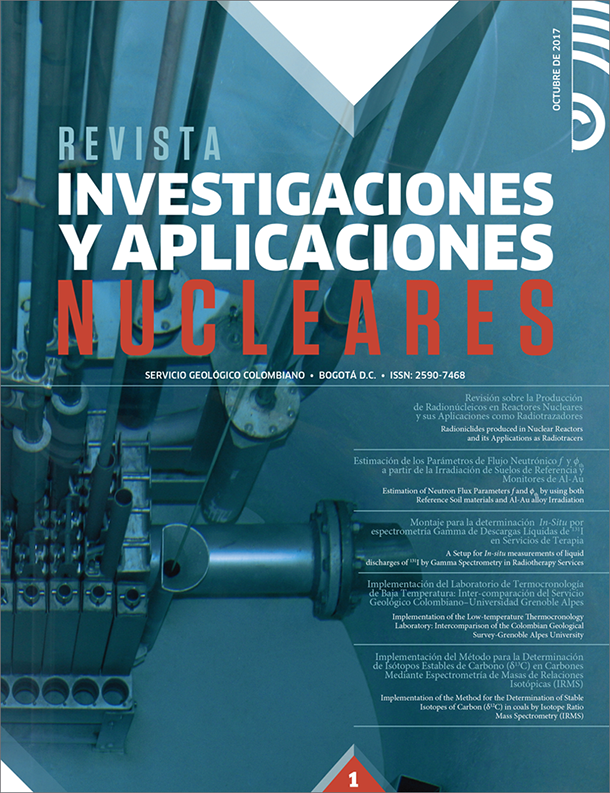A setup for in situ measurements of liquid discharges of 131I by gamma spectrometry in radiotherapy services
DOI:
https://doi.org/10.32685/2590-7468/invapnuclear.1.2017.19Keywords:
131I, Radioactive discharges, HpGe Detector, Iodine, in situ gamma-ray spectrometryDownloads
How to Cite
Issue
Section
Published
Abstract
This paper presents an alternative for determining the activity discharged 131I in the dumping of nuclear medicine facilities that perform therapy, a mount for the in situ determination of liquid discharges of 131I by spectrometry technique developed gamma high resolution using hyperpure germanium detector. The assembly constructed simulated actual discharge conditions in an installation, in order to fine-tune the measurement system used, determining the parameters of
efficiency, uncertainty and detection limit.
References
-[1] E. O. Ruiz, “La Medicina Nuclear,” Academia Nacional de Medicina - Asociación Colombiana de Medicina Nuclear, p. 13, 2002.
-[2] United Nations Scientific Committee on the Effects of Atomic Radiation and UNSCEAR 2008. Report to the General Assembly with Scientific Annexes, “Sources and effects of Ionizing Radiation,” 2010.
-[3] International Commission on Radiological Protection, “Release of patients after therapy with unsealed radionuclides,” Ann. ICRP, vol. 34, no. 2, pp. 1-79, 2004.
-[4] International Atomic Energy Agency - IAEA, “Safety Reports Series N° 63, Release of Patients After Radionuclide therapy,” Vienna, 2009.
-[5] International Atomic Energy Agency-IAEA, “Setting Authorized Limits for Radioactive Discharges: Practical Issues to Consider,” Vienna, 2010.
-[6] R. Barquero, F. Basurto, C. Núñez, and R. Esteban, “Liquid discharges from patients undergoing 131I treatments,” J. Environ. Radioact., vol. 99, no. 10, pp. 1530–1534. Oct. 2008.
-[7] Ministerio de Minas y Energía, Resolución 4 1178 “Por la cual se modifica la Resolución 18 0005.” Colombia, 2016.
-[8] Ministerio de Minas y Energía, Resolución número 18 0005, Reglamento para la gestión de los desechos radiactivos. Colombia, 2010, pp. 1–84.
-[9] E. Krawczyk, F. Piñero-García, and M. a Ferro- García, “Discharges of nuclear medicine radioisotopes in Spanish hospitals,” J. Environ. Radioact., vol. 116, pp. 93–8, Mar. 2013.
-[10] P. S. Rose, R. L. Swanson, and J. K. Cochran, “Medically-derived 131I in municipal sewage euent,” Water Res., vol. 46, no. 17, pp. 5663–5671, 2012.
-[11] C. Tsabaris, D. L. Patiris, A. P. Karageorgis, G. Eleftheriou, V. P. Papadopoulos, D. Georgopoulos, E. Papathanassiou, and P. P. Povinec, “In situ radionuclide characterization of a submarine groundwater discharge site at Kalogria Bay, Stoupa, Greece,” J. Environ. Radioact., vol. 108, pp. 50–59, 2012.
-[12] R. Berndt and P. Mortreau, “Performance test of the Multi-Channel Analyzer MCA-527 for Nuclear Safeguards Applications,” Report EUR 26165 EN, 2013.
-[13] M. Bé, V. Chisté, C. Dulieu, V. Chechev, N. Kuzmenko, and M. Galán, Table of Radionuclides (Vol. 1 - A = 1 to 150). Pavillon de Breteuil, 2004.
-[14] Empresa de Acueducto y Alcantarillado de Bogotá -EAAB-, Requisitos mínimos para cajas de inspección externa para efluentes industriales. 2001, pp. 1–4.
-[15] International Organization for Standardization - ISO, “ISO 11929:2010 - Determination of the characteristic limits (decision threshold, detection limit and limits of the confidence interval) for measurements of ionizing radiation -- Fundamentals and application,” 2010.
-[16] International Atomic Energy Agency - IAEA, “Clearance of materials resulting from the use of radionuclides in medicine, industry and research - TECDOC 1000,” Vienna, 1998.







